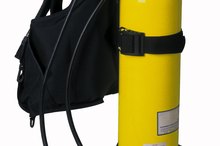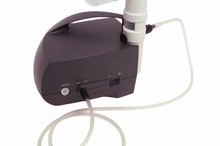Differences Between Oxygen Tanks & Oxygen Concentrators
Oxygen tanks and oxygen concentrators are prescribed by doctors for patients needing oxygen therapy. Oxygen therapy assists with certain respiratory diseases such as chronic obstructive pulmonary disease, cystic fibrosis or heart failure -- to better maintain adequate blood oxygen levels. There are two basic methods to provide supplementary oxygen: Oxygen tanks and oxygen concentrators. Although they work in different manners, both devices provide additional oxygen via either a nasal cannula, a thin tube with two prongs that fits into the nose, or a mask which covers nose and mouth. Lifestyle is often the key factor in determining which type of oxygen therapy is ideal for you, and many patients use a combination of oxygen tanks and oxygen concentrators.
Oxygen Tanks
Oxygen tanks contain either compressed oxygen gas or liquid oxygen. These tanks deliver pure oxygen to patients. Tanks must be professionally filled and then delivered to your home. Small tanks of compressed oxygen can be carried around for mobile use. Larger tanks can be delivered to your home. The American Association for Respiratory Care warns patients that, "Large tanks are heavy and are only suitable for stationary use." Liquid oxygen takes up less space and is lighter than oxygen gas, which makes it particularly effective for small mobile tanks -- however, liquid oxygen tanks are more expensive than compressed oxygen gas tanks 2. According to WebMD, patients utilizing oxygen tanks while traveling should know how long the oxygen supplied by the canister lasts -- and bring refills if needed. Patients needing high levels of oxygen may need to travel with multiple small tanks when away from home for extended periods.
- Oxygen tanks contain either compressed oxygen gas or liquid oxygen.
- According to WebMD, patients utilizing oxygen tanks while traveling should know how long the oxygen supplied by the canister lasts -- and bring refills if needed.
Oxygen Concentrators
What Are the Side Effects of Oxygen Therapy?
Learn More
Oxygen concentrators are machines that take in air from their surroundings, and concentrates the oxygen found in the air. This concentrated oxygen, which is now 95 percent pure, is then delivered to the patient. Oxygen concentrators are run with electricity, so a backup oxygen tank must be kept on hand in case of power failure. Original oxygen concentrators were large machines that could only be used at home, but new models of portable oxygen concentrators allow greater mobility and freedom. The biggest drawback to oxygen concentrators is the dependence of the machine on electrical power. If there is an electrical outage or the battery on a mobile unit fails, the machine does not provide oxygen.
- Oxygen concentrators are machines that take in air from their surroundings, and concentrates the oxygen found in the air.
- Oxygen concentrators are run with electricity, so a backup oxygen tank must be kept on hand in case of power failure.
Warning
When using oxygen therapy, you must be aware of the extreme danger that fire poses to your safety 1. Oxygen feeds fire, and the concentrated oxygen being delivered to patients utilizing either oxygen tanks or oxygen concentrators, can cause fire to flare up in a violent way. You should not smoke while administering oxygen therapy. The concentrators should be at least five feet away from open flames.
- When using oxygen therapy, you must be aware of the extreme danger that fire poses to your safety 1.
- The concentrators should be at least five feet away from open flames.
Related Articles
References
- WedMD: Using Oxygen Therapy, Using Oxygen at Home
- Things to Know When Using Oxygen Therapy. American Lung Association. August 23, 2018
- The Long-Term Oxygen Treatment Trial Research Group. A Randomized Trial of Long-Term Oxygen for COPD with Moderate Desaturation. The New England Journal of Medicine. 2016;375(17):1617-1627. doi:10.1056/NEJMoa1604344.
- American Lung Association. Supplemental Oxygen. 2017.
- Shah SA, Velardo C, Farmer A, Tarassenko L. Exacerbations in Chronic Obstructive Pulmonary Disease: Identification and Prediction Using a Digital Health System. Eysenbach G, ed. Journal of Medical Internet Research. 2017;19(3):e69. doi:10.2196/jmir.7207.
- Turan O, Ure I, Turan PA. Erectile dysfunction in COPD patients. Chron Respir Dis. 2016;13(1):5–12. doi:10.1177/1479972315619382
- Traveling with Oxygen. American Lung Association. October 3, 2018
- Nishimura M. High-flow nasal cannula oxygen therapy in adults. J Intensive Care. 2015;3(1):15. Published 2015 Mar 31. doi:10.1186/s40560-015-0084-5
- Abdo WF, Heunks LM. Oxygen-induced hypercapnia in COPD: myths and facts. Crit Care. 2012;16(5):323. Published 2012 Oct 29. doi:10.1186/cc11475
- American Thoracic Society. Patient Education Information Series. Oxygen Therapy. 2016.
Writer Bio
Eli McCormack has been writing professionally since 2005. McCormack began her writing career working for her local newspaper, "The Examiner," by covering local government stories. McCormack holds a Bachelor of Science in political science and Latin American studies from DePaul University and a Master of Arts in public administration from Northern Illinois University.









